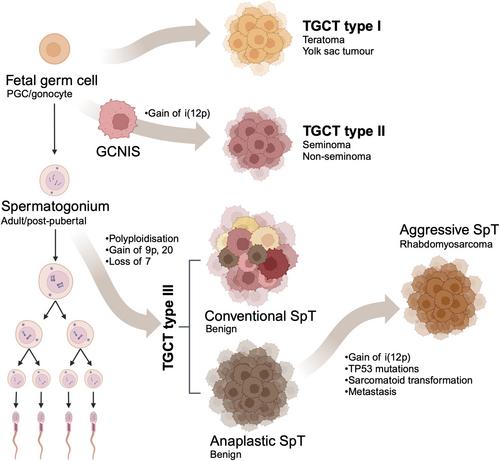下载PDF
{"title":"New analysis of atypical spermatocytic tumours reveals extensive heterogeneity and plasticity of germ cell tumours†","authors":"Ewa Rajpert-De Meyts, Anne Goriely, Kristian Almstrup","doi":"10.1002/path.6262","DOIUrl":null,"url":null,"abstract":"<p>Testicular germ cell tumours (TGCTs) derived from immature (type I) and pluripotent germ cell neoplasia <i>in situ</i> (GCNIS, type II) are characterised by remarkable phenotypic heterogeneity and plasticity. In contrast, the rare spermatocytic tumour (SpT, type III), derived from mature spermatogonia, is considered a homogenous and benign tumour but may occasionally present as an anaplastic or an aggressive sarcomatoid tumour. While various oncogenic processes had been proposed, the precise mechanism driving malignant progression remained elusive until the molecular characterisation of a series of atypical SpTs described in a recent issue of <i>The Journal of Pathology.</i> The emerging picture suggests the presence of two distinct trajectories for SpTs, involving either RAS/mitogen-activated protein kinase pathway mutations or a ploidy shift with secondary <i>TP53</i> mutations and/or gain of chromosome 12p, the latter known as pathognomonic for type II GCNIS-derived TGCTs. Here, we discuss the implications of these findings, seen from the perspective of germ cell biology and the unique features of different TGCTs. The evolving phenotype of SpTs, induced by genomic and epigenetic changes, illustrates that the concept of plasticity applies to all germ cell tumours, making them inherently heterogenous and capable of significant transformation during progression. © 2024 The Authors. <i>The Journal of Pathology</i> published by John Wiley & Sons Ltd on behalf of The Pathological Society of Great Britain and Ireland.</p>","PeriodicalId":232,"journal":{"name":"The Journal of Pathology","volume":"263 1","pages":"1-4"},"PeriodicalIF":5.6000,"publicationDate":"2024-02-16","publicationTypes":"Journal Article","fieldsOfStudy":null,"isOpenAccess":false,"openAccessPdf":"https://onlinelibrary.wiley.com/doi/epdf/10.1002/path.6262","citationCount":"0","resultStr":null,"platform":"Semanticscholar","paperid":null,"PeriodicalName":"The Journal of Pathology","FirstCategoryId":"3","ListUrlMain":"https://onlinelibrary.wiley.com/doi/10.1002/path.6262","RegionNum":2,"RegionCategory":"医学","ArticlePicture":[],"TitleCN":null,"AbstractTextCN":null,"PMCID":null,"EPubDate":"","PubModel":"","JCR":"Q1","JCRName":"ONCOLOGY","Score":null,"Total":0}
引用次数: 0
引用
批量引用
Abstract
Testicular germ cell tumours (TGCTs) derived from immature (type I) and pluripotent germ cell neoplasia in situ (GCNIS, type II) are characterised by remarkable phenotypic heterogeneity and plasticity. In contrast, the rare spermatocytic tumour (SpT, type III), derived from mature spermatogonia, is considered a homogenous and benign tumour but may occasionally present as an anaplastic or an aggressive sarcomatoid tumour. While various oncogenic processes had been proposed, the precise mechanism driving malignant progression remained elusive until the molecular characterisation of a series of atypical SpTs described in a recent issue of The Journal of Pathology. The emerging picture suggests the presence of two distinct trajectories for SpTs, involving either RAS/mitogen-activated protein kinase pathway mutations or a ploidy shift with secondary TP53 mutations and/or gain of chromosome 12p, the latter known as pathognomonic for type II GCNIS-derived TGCTs. Here, we discuss the implications of these findings, seen from the perspective of germ cell biology and the unique features of different TGCTs. The evolving phenotype of SpTs, induced by genomic and epigenetic changes, illustrates that the concept of plasticity applies to all germ cell tumours, making them inherently heterogenous and capable of significant transformation during progression. © 2024 The Authors. The Journal of Pathology published by John Wiley & Sons Ltd on behalf of The Pathological Society of Great Britain and Ireland.
对非典型精原细胞瘤的新分析揭示了生殖细胞瘤的广泛异质性和可塑性†。
睾丸生殖细胞瘤(TGCT)来源于未成熟细胞(I 型)和多能生殖细胞原位肿瘤(GCNIS,II 型),具有显著的表型异质性和可塑性。相比之下,罕见的精原细胞瘤(SpT,III 型)源自成熟的精原细胞,被认为是一种同质性良性肿瘤,但偶尔也会表现为无性或侵袭性肉瘤。虽然人们提出了各种致癌过程,但在最近一期《病理学杂志》对一系列非典型 SpTs 进行分子鉴定之前,驱动恶性进展的确切机制仍然难以确定。新的研究结果表明,SpTs存在两种不同的发展轨迹,一种是RAS/介原激活蛋白激酶通路突变,另一种是伴有继发性TP53突变和/或染色体12p增益的倍性转移,后者被认为是II型GCNIS衍生型TGCTs的病理标志。在此,我们将从生殖细胞生物学的角度和不同 TGCT 的独特特征来讨论这些发现的意义。由基因组和表观遗传学变化诱导的 SpTs 表型不断演变,说明可塑性的概念适用于所有生殖细胞肿瘤,使它们具有内在的异质性,并能在发展过程中发生重大转变。© 2024 作者。病理学杂志》由约翰威利父子有限公司代表大不列颠及爱尔兰病理学会出版。
本文章由计算机程序翻译,如有差异,请以英文原文为准。


 求助内容:
求助内容: 应助结果提醒方式:
应助结果提醒方式:


